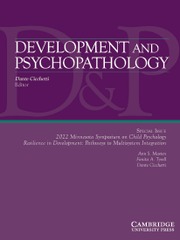Crossref Citations
This article has been cited by the following publications. This list is generated based on data provided by
Crossref.
Cicchetti, Dante
and
Rogosch, Fred A.
1999.
Psychopathology as Risk for Adolescent Substance Use Disorders: A Developmental Psychopathology Perspective.
Journal of Clinical Child Psychology,
Vol. 28,
Issue. 3,
p.
355.
Brewis, Alexandra
Schmidt, Karen L.
and
Meyer, Mary
2000.
ADHD‐Type Behavior and Harmful Dysfunction in Childhood: A Cross‐Cultural Model.
American Anthropologist,
Vol. 102,
Issue. 4,
p.
823.
Wakefield, Jerome C
2001.
The myth of DSM's invention of new categories of disorder: Houts's diagnostic discontinuity thesis disconfirmed.
Behaviour Research and Therapy,
Vol. 39,
Issue. 5,
p.
575.
Holmes, Georgina E.
Williams, Christopher L.
and
Haines, Janet
2001.
Motor vehicle accident trauma exposure: Personality profiles associated with posttraumatic diagnoses.
Anxiety, Stress & Coping,
Vol. 14,
Issue. 3,
p.
301.
Power, Thomas J.
Manz, Patricia H.
and
Leff, Stephen S.
2002.
Handbook of School Mental Health Advancing Practice and Research.
p.
257.
Baron-Cohen, Simon
2002.
Is Asperger Syndrome Necessarily Viewed as a Disability?.
Focus on Autism and Other Developmental Disabilities,
Vol. 17,
Issue. 3,
p.
186.
Cummings, E. Mark
Braungart‐Rieker, Julia M.
and
Du Rocher‐Schudlich, Tina
2003.
Handbook of Psychology.
p.
211.
Curry, Vicky
2003.
Thurston High School.
Journal of School Violence,
Vol. 2,
Issue. 3,
p.
93.
Lorion, Raymond P.
and
Sokoloff, Harris
2003.
Developmental Assets and Asset-Building Communities.
p.
121.
Power, Thomas J.
2003.
Promoting Children's Mental Health: Reform Through Interdisciplinary and Community Partnerships.
School Psychology Review,
Vol. 32,
Issue. 1,
p.
3.
Barkley, Russell A.
2004.
Critique or Misrepresentation? A Reply to Timimi et al..
Clinical Child and Family Psychology Review,
Vol. 7,
Issue. 1,
p.
65.
Petermann, Franz
Niebank, Kay
and
Scheithauer, Herbert
2004.
Entwicklungswissenschaft.
p.
293.
SMÁRI, JAKOB
and
STEFÁNSSON, SIGURJÓN B.
2004.
Mental störning som en skadlig dysfunktion: framsteg eller irrvägar.
Nordisk Psykologi,
Vol. 56,
Issue. 3,
p.
201.
Bellinger, David C
2004.
What is an adverse effect? A possible resolution of clinical and epidemiological perspectives on neurobehavioral toxicity.
Environmental Research,
Vol. 95,
Issue. 3,
p.
394.
Giummarra, Melita J.
and
Haslam, Nick
2005.
The Lay Concept of Childhood Mental Disorder.
Child Psychiatry and Human Development,
Vol. 35,
Issue. 3,
p.
265.
Wakschlag, Lauren S.
Leventhal, Bennett L.
Briggs-Gowan, Margaret J.
Danis, Barbara
Keenan, Kate
Hill, Carri
Egger, Helen L.
Cicchetti, Domenic
and
Carter, Alice S.
2005.
Defining the “Disruptive” in Preschool Behavior: What Diagnostic Observation Can Teach Us.
Clinical Child and Family Psychology Review,
Vol. 8,
Issue. 3,
p.
183.
Bellinger, David C.
2005.
Neurotoxicity and Developmental Disabilities.
Vol. 30,
Issue. ,
p.
263.
Perring, Christian
2006.
Conceptualiser les troubles mentaux chez les enfants et les adolescents.
Philosophiques,
Vol. 33,
Issue. 1,
p.
65.
Wittchen, H. -U.
and
Hoyer, J.
2006.
Klinische Psychologie & Psychotherapie.
p.
3.
Sonuga-Barke, Edmund J.S.
Sergeant, Joseph A.
Nigg, Joel
and
Willcutt, Erik
2008.
Executive Dysfunction and Delay Aversion in Attention Deficit Hyperactivity Disorder: Nosologic and Diagnostic Implications.
Child and Adolescent Psychiatric Clinics of North America,
Vol. 17,
Issue. 2,
p.
367.

